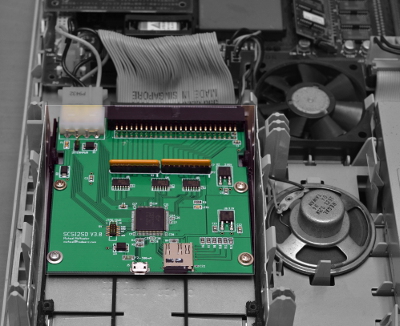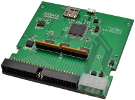SCSI2SD: Difference between revisions
m →Compatibility: Adding more compatible devices |
|||
| Line 97: | Line 97: | ||
* Mac SE/30 | * Mac SE/30 | ||
* Roland JS-30 Sampler | * Roland JS-30 Sampler | ||
* Akai S3200 | * Akai S3200 and S1000 Samplers | ||
* [[EMU Emulator E4X]] with EOS 3.00b | * [[EMU Emulator E4X]] with EOS 3.00b | ||
* Ensoniq ASR-X | |||
* HP 16601A logic analyzer | |||
There are compatibility problems with the following samplers. I have acquired an Akai sampler and expect to resolve the problems in the near future. | There are compatibility problems with the following samplers. I have acquired an Akai sampler and expect to resolve the problems in the near future. | ||
* Akai MPC3000 | * Akai MPC3000 | ||
Revision as of 10:36, 14 April 2014
The SCSI Hard Drive Emulator for retro computing.
News
[16 Feb 2014] v3.2 firmware released. This is an important bugfix release. All SCSI2SD users are urged to upgrade to this version.
[02 Feb 2014] I've created the SCSI2SD FAQ to answer some common questions. I am currently working on resolving compatibility issues with some samplers, adding configurable sector-sizes, and creating a smaller 2.5" version to suit old Powerbooks.
[17 Jan 2014] Sign up for the SCSI2SD mailing lists for firmware update notifications.
[27 Dec 2013] v3.1 firmware released.
- Fix for reading the last sector of the SD card.
- Performance improvements. 2.5x read, 2x write performance.
[9 Dec 2013] v3.0.1 firmware released.
Overview
Traditional hard drives last 5 years*. Maybe, if you're luckly, you'll get 10 years of service from a particular drive. The lubricants wear out, the spindles rust. SCSI2SD is a modern replacement for failed drives. It allows the use of vintage computer hardware long after their mechanical drives fail. The use of SD memory cards solves the problem of transferring data between the vintage computer and a modern PC (who still has access to a working floppy drive ?)
*All statistics are made up.
Purchase
I am actively building and selling SCSI2SD devices.
Features
- In-built active terminator.
- Can optional supply terminator power back to the SCSI bus
- Emulates a non-removable hard drive for maximum compatibility.
- Firmware updatable over USB
- Highly configurable over USB
- Selectable SCSI ID
- Selectable parity support
- Enable/disable Unit Attention Condition
- Artificial limits on the SCSI disk size (eg. limit size to 4G to avoid OS bugs)
Technical Specifications
| SCSI Interface | SCSI-2 Narrow 8-bit 50-pin connector. Supports asynchronous transfers only. |
| SD Card Interface | Standard SDSC (1GB maximum size) SDHC (32GB maximum size) |
| Power | 5V via standard molex drive connector. |
| Dimensions | 10cm x 10cm x 1.5cm
A 3D-printable bracket is available to mount in a standard 3.5" hard disk bay. |
Performance
As currently implemented:
Sequential read: 930kb/sec Sequential write: 900kb/sec
Tested with a 16GB class 10 SD card, via the commands:
# WRITE TEST sudo dd bs=8192 count=100 if=/dev/zero of=/dev/sdX oflag=dsync
# READ TEST sudo dd bs=8192 count=100 if=/dev/sdX of=/dev/null
For comparison, here are some benchmarks of some older SCSI hardware.
Compatibility
Tested with Linux (current), Apple Macintosh System 7.5.3 on LC-III, and LC-475 hardware.
Users have reported success on these systems:
- Mac II running System 6.0.8
- Mac SE/30
- Roland JS-30 Sampler
- Akai S3200 and S1000 Samplers
- EMU Emulator E4X with EOS 3.00b
- Ensoniq ASR-X
- HP 16601A logic analyzer
There are compatibility problems with the following samplers. I have acquired an Akai sampler and expect to resolve the problems in the near future.
- Akai MPC3000
Files
Firmware update utility and configuration tool download.
These files are currently available for Windows and Linux (64bit, requires the libudev1 package).
The schematics, pcb layout, and source code is managed under the git version control system. A copy of all sources can be obtained via the command:
git clone --recursive git://www.codesrc.com/git/SCSI2SD
Alternatively, the git sources can be viewed using your web browser by clicking here.
The schematics and PCB layout files can be viewed/edited with the free gEDA tools. For those without access to gEDA, I've exported the content as PDF:
The software is built using the Cypress PSoC Creator IDE.
Howto
- SCSI2SD FAQ
- SCSI2SD UserManual
- FormatWithBasiliskII Format an SD card for use with Apple Macintosh hardware using the Basilisk II emulator
Alternative Open SCSI Projects
- AJ's alternative implementation. AJ and I originally had a competition to design and build a SCSI device to boot an old Mac LCIII. The deadline for that competition has long-since expired without a winner, but we have both continued to progress our designs.
- S2I (was: SCSI2IDE)
- AVR based SCSI RAM disk
Old
For historical project information see SCSI2SD old

